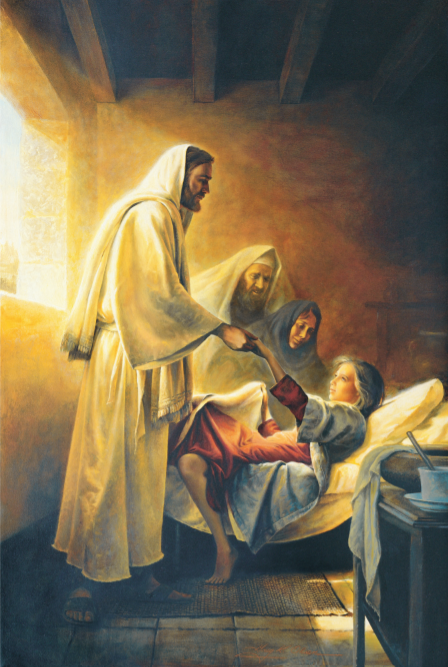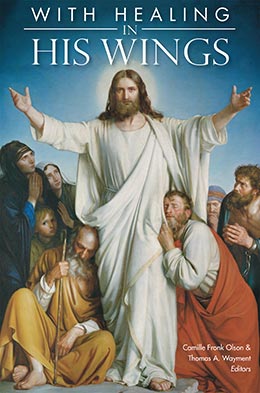Foreword
Camille Fronk Olson and Thomas A. Wayment, “Christ’s Crucifixion: Reclamation of the Cross” in With Healing in His Wings, ed. Camille Fronk Olson and Thomas A. Wayment (Provo, UT: Religious Studies Center; Salt Lake City: Deseret Book, 2013), vii–ix.
When potential danger nears, a mother hen instinctively lifts her wings to protect her chicks and offers immediate refuge to them. When she lowers those ample wings to enfold her little ones, she stoically faces the source of danger. In her defensive posture, she creates a refuge that potentially places her life at risk. Interestingly, at times, prophets have compared various aspects of the Savior’s ministry to the mother hen, teaching that he has healing in his wings. The Savior likewise used that metaphor to describe his own power to offer refuge to his followers. By likening himself to a mother hen, the Savior testifies that he will cover us symbolically with his wings to save us if we, like the chicks, will come to him.
 President Howard W. Hunter taught: “Whatever Jesus lays his hands upon lives. If Jesus lays his hands upon a marriage it lives. If he is allowed to lay his hands on the family, it lives.” (Greg Olsen, Christ Raising the Daughter of Jairus, © Intellectual Reserve, Inc.)
President Howard W. Hunter taught: “Whatever Jesus lays his hands upon lives. If Jesus lays his hands upon a marriage it lives. If he is allowed to lay his hands on the family, it lives.” (Greg Olsen, Christ Raising the Daughter of Jairus, © Intellectual Reserve, Inc.)
His wings, however, do more than protect. He has gathered us in the past and will continue to gather us in the present and future “as a hen gathereth her chickens under her wings, if [we] will repent and return unto [him] with full purpose of heart” (3 Nephi 10:6; see also vv. 4–5). All of God’s children are invited to be gathered, “or come to the knowledge of . . . their Redeemer” (1 Nephi 10:14; see also 15:14–15), where they will receive the saving covenants and ordinances of the gospel. Nowhere is the expansive reach of his merciful power more evident than in events associated with his Passion and victory over the grave—events that form the foundation of our Easter celebration. After Jesus was crucified for the sins of the world and lay in a tomb for three days, he rose from the dead “with healing in his wings” (2 Nephi 25:13; see also Malachi 4:2; 3 Nephi 25:2).
Because of his infinite Atonement, the Savior’s capacity to heal is likewise ever- and far- reaching. In scripture, his healing is metaphorically associated with wings. This lyrical language spoken by the ancients connotes “the power of the Atonement to overcome sin and death and ‘to comfort all that mourn’ (Isa. 61:2) and ‘wipe away tears from off all faces’ (Isa. 25:8; Rev. 21:4).” [1] The Prophet Joseph Smith received revelation that wings on God’s creations in the Revelation of John are a “representation of power, to move, to act, etc.” (D&C 77:4; see also Revelation 4:6–11). Jesus Christ rose from the dead with power to heal all manner of pains, temptations, and ills, his figurative healing wings working through the power of the Atonement. President Howard W. Hunter taught: “Whatever Jesus lays his hands upon lives. If Jesus lays his hands upon a marriage, it lives. If he is allowed to lay his hands on the family, it lives.” [2] There are no bounds to his capacity to succor or to limit those he can heal. As he encircles us with his almighty wings, he grants us power, confidence, and wisdom to invite others to come and renew hope for a better day.
Charles Wesley penned these stirring words, included in one of our hymns, to praise Jesus as the “lover of my soul”:
Other refuge have I none;
Hangs my helpless soul on thee.
Leave, oh, leave me not alone;
Still support and comfort me.
All my trust on thee is stayed;
All my help from thee I bring.
Cover my defenseless head
With the shadow of thy wing. [3]
Every day of the year, but in a special way at Easter time, we reverence the supreme sacrifice that our God offered for us and rejoice in his magnanimous healing that he alone provides. The essays published in this volume were delivered at the annual Brigham Young University Easter Conferences in 2012 and 2013. May the presenters’ insights, both academic and personal, enlighten your testimony of Jesus Christ and contribute to your celebration of the Easter season. Above all, we hope this collection will entice you to recognize and express gratitude for his healing power in your own life.
Notes
[1] David R. Seely, “Malachi chapter review: 3 Nephi 24–25//
[2] Howard W. Hunter, “Reading the Scriptures,” Ensign, November 1979, 64; see also Conference Report, October 1979, 93.
[3] Charles Wesley, “Jesus, Lover of My Soul,” Hymns (Salt Lake City: The Church of Jesus Christ of Latter-day Saints, 1985), no. 102.
